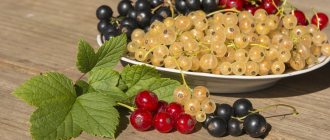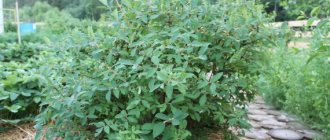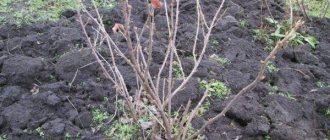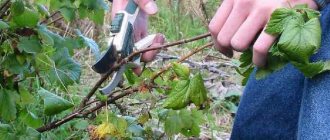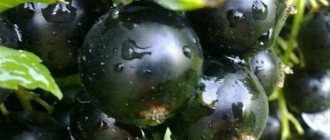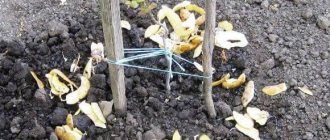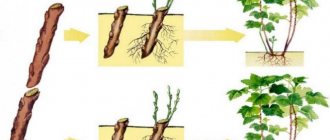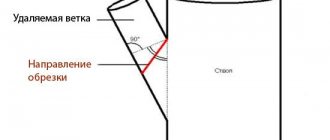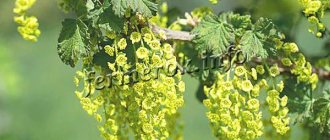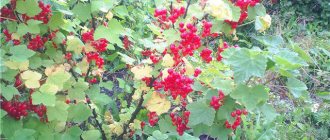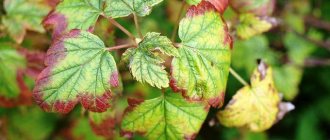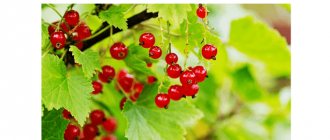» Gardening » Currants » How to properly rejuvenate currants in the fall
0
467
Article rating
Many gardeners try to rejuvenate currants in the fall. This procedure helps increase productivity and gives the fruit and berry plant a cultivated appearance. Pruning also serves as a way to protect shrubs from pests and infectious diseases.
- Basic Rules
- Required Tools
- Rejuvenation technology
- red currant
- black currant
- Aftercare
- Common mistakes
How to properly rejuvenate currants in the fall
Dates
Pruning is performed at a certain time. The plant tolerates the removal of branches more easily if this procedure is carried out during a period of weak sap flow. Accordingly, the most extensive pruning is performed in early spring or autumn, and, if necessary, in summer. This link will tell you about the characteristics and description of the Red Arrow tomato variety.
Spring
The purpose of the procedure can be different: young currants are pruned to form a bush, a fruit-bearing plant is pruned to increase productivity, an old bush is rejuvenated.
Pruning in spring allows for maximum removal of shoots from the total volume - up to 1/3 of all branches.
In the spring, the main part of the pruning is carried out.
Pruning is performed as soon as the temperature stabilizes: at night it does not fall below 0 C, and during the day it is kept at least +5 C. If frost is expected, the procedure will have to be postponed. At the same time, it can only be carried out until the buds open, so the gardener does not have much time. Find out about the beneficial properties of Yalta onions here.
As soon as active sap flow begins, the healing of cut wounds slows down greatly. An open wound surface is an excellent breeding ground for pathogenic bacteria. As a result, untimely pruning leads to weakening of the bush and the appearance of diseases.
Summer
In summer, sap flow is very active, so pruning is performed only as necessary:
- old and broken branches are removed regardless of the time of year, as they only get in the way. If the currant is infected or damaged by insects, then the diseased shoots are also cut out mercilessly and at any time;
- In summer, pinching is carried out: targeted damage to new green growths - plucking the top in order to stimulate the development of lateral branches;
- after harvesting - in August, sanitary pruning is allowed, especially if autumn in the region is early and cold.
In summer, it is more important than ever to cover the cuts with garden varnish. Otherwise, infection is inevitable.
Autumn
Autumn pruning is done 2-3 weeks before the onset of cold weather. As a rule, the bulk of the leaves have already been shed by this time. If autumn is cold in the region and frosts occur almost before the leaves fall, it is better to prune in the spring. Under the influence of cold, the tips of the shoots will freeze and all the work done will be in vain. Read about the characteristics and description of the Benito F1 tomato variety here.
If juice is released from the cut, then it is too early to prune.
In the fall, basic sanitary pruning is performed, ridding the bush of damaged and diseased branches, and some of the rejuvenating is also carried out. An essential element of autumn currant care is collecting and burning the foliage.
Winter
This form of care is performed in the case of warm, snowless winters. Theoretically, currants are not in danger of infection; cuts are easily tightened in the spring. However, winter pruning is allowed only on absolutely healthy bushes. If the currant is weakened or sick, this option will lead to the death of the bush.
Volumetric – shaping or rejuvenating – pruning is not allowed in the cold season. This is out of the question.
Kinds
Bush pruning is done for a variety of purposes. All procedures are united by one factor – necessity. From the moment of planting until the last year of existence, currants should be looked after.
Before boarding
For planting, 1- or 2-year-old seedlings are purchased.
Such bushes should have 3–4 branches, and the length of each shoot should reach at least 50–80 cm. The first pruning is carried out not before, but immediately after planting. This is necessary for proper formation of the bush and stimulation of growth. This article will tell you about large-fruited tomato varieties for greenhouses.
Black
Black currants should form a fairly wide bush of 5-7 main branches. Formation takes 3 years. But in order to cause the appearance of new powerful shoots, it is necessary to immediately cut off each existing branch by 2-3 buds immediately after planting.
Cut the shoot along the upper bud - step back 5 mm from it. The cutting angle is 45 degrees. Be sure to treat the cut with garden varnish.
White and red
The first pruning of red and white currants is no different from the procedure for black currants. After planting, the main branches of the seedling are severely cut off, leaving 2–3 null shoots – growing straight from the root.
Pruning is done at 3-4 buds, the oblique cut is at 45 degrees. The length of the shoot after this does not exceed 20 cm.
Formative trimmings
The purpose of formative pruning is to create a bush. What is meant is not so much the shape, but rather the ratio of old and young branches, which ensures both high yield and the ability of the plant to develop and recover.
Drawing. Formation of a bush of red and white currants.
The average period of formative pruning is 4 years. During this time, a bush is formed with 5–7 main shoots of different ages. Subsequently, a maintenance procedure is performed. Its essence comes down to the timely removal of old branches - 5-6 years old, since their yield is greatly reduced, and stimulation of the growth of young shoots.
With each pruning of this type, 2-3 new strong shoots are left. By the 4th year, currants should be a branched, but not dense bush with a wide spreading crown.
If the bush is planted at a minimum distance, leave the minimum number of branches so that the bushes are tall, but not too wide. If the distance between plants allows, then leave more branches.
Anti-aging
The lifespan of currants and the harvest time depend on the general condition of the bush. If there are too many old branches, then there are fewer berries, the bush grows weakly, withers and becomes prone to disease.
Black currant requires anti-aging pruning already in the 5th year of life, since the bush develops and bears fruit very actively. For this purpose, red and white currants are pruned at the 8th year.
The essence of the rejuvenating procedure is the complete removal of all old main branches, starting from the zero ones, in order to replace them with later ones that bear fruit well. – 2–3 year olds. Pruning is carried out in several stages, since it is impossible to immediately deprive the bush of all skeletal shoots. Several different technologies are used:
- cutting into a ring - that is, completely removing the branch at the root. This is how old branches older than 5 years are removed. The cut must be treated with antimicrobial agents and covered with garden pitch;
- removal to the bud - thus stimulating the branching of the branch. If the bush is too dense, then cut it to the outer bud so that the shoots grow to the sides. If it is too sparse, cut under the inner bud. In this case, the shoots grow inward and the currants become thicker;
- pinching is an additional method used both to stimulate growth and as an element of anti-aging pruning;
- pruning for increased branching - strong side branches are cut in half, 5 mm above the bud. The next year a new shoot appears here, and the neighboring ones produce strong lateral branches. This increases the yield of currants.
The latter method is more often used on red and white currants. In black, old shoots do not produce berries at all, so there is no point in shortening them. Old branches of red and white can bear fruit, but to increase the number of berries, pruning is done to branch.
Sanitary
This part of the care is carried out as needed: from early spring to late autumn. Wherein:
- broken, frozen, diseased and weakened shoots are removed;
- Top and basal shoots are cut out, since they do not bear fruit. This procedure is usually performed in the spring;
- in spring and autumn, “extra” shoots are eliminated: crowns growing inwards, blocking access to the sun, as well as branches growing horizontally or downwards.
It is recommended to avoid summer pruning if the plant is growing poorly and is weakened.
Topping
It is not so much a pruning as an element of care. Currant branches stop actively growing by mid-July, as the plant requires nutrients to ripen the berries. Accordingly, this year’s new shoots do not have time to develop into full-fledged shoots before winter, that is, they are not covered with normal bark. The risk of frostbite is very high.
Pinching is carried out in June-July. It is advisable not to delay the procedure until the end of summer, since such shoots absorb nutrients and prevent the fruit from ripening. The technology is simple: 1-2 buds are cut off at the ends of the skeletal and root branches. They use pruning shears for the procedure, although experienced gardeners simply unscrew the stem and leaf.
Pinching is performed only on black currants. In red and white berries, berries are formed at the ends of the shoots, so the procedure leads to a decrease in yield.
Trimming methods
There are also not quite typical pruning options.
Under some conditions they also give good results. For example, the simplest pruning, which can be done with ease even by beginners, is to remove all branches that have grown less than 15 cm over the summer. The older the currant branch, the less growth it gives. Accordingly, with such care, the oldest shoots are cut out, and the bush is constantly renewed.
There are also more complex methods.
Michurinskaya
The method is recommended for use when growing berries for sale and with a large plantation area. The procedure is as follows.
- For the first 5 years, the bush grows freely; pruning is not performed.
- Approximately half of the currants are cut off at the root and diligently fed at 5–6 years.
- The next year, up to 80% of the shoots are removed, leaving the strongest ones.
- In the second year, the remaining 50% of the bushes are also cut off at the root and fed. On the third day, more than half of the shoots are cut off from this 50%.
- After 2-3 years, all the currants are mowed down and the roots are uprooted. Then new bushes are planted in the vacant space.
Michurin pruning allows you to radically renew the berry garden and get the maximum yield in these 10 years. For ordinary summer cottages, this method is not recommended, as it requires enhanced agricultural technology.
Stambovaya
This form is more suitable for ornamental shrubs. But since currants, especially black currants, may well act in this capacity, this kind of pruning is also applied to them.
The procedure is performed step by step.
- Immediately after planting, the side branches located at a height of more than 20–40 cm from the ground are cut off the bush.
- The central shoot is cut off so that 2-3 buds remain.
- In summer, the bush is given the shape of a tree using pinching. At the level of the future “crown”, the tops of the branches are removed in order to form the desired shape. In this case, 2–3 lower buds are left on the shoot.
- The next year, cut off parts of the branches so that each is no longer than 10 cm.
- During subsequent pruning, the branches are shortened to a length of 20 cm from the trunk.
- Every year the trunk is cleaned of excess side shoots that spoil the shape of the crown.
The lifespan of the trunk is 12–15 years. The bush does not produce a large harvest, but it looks extremely impressive, especially when it comes to red currants.
Thinning out forks to side branches
On currants, like on other shrubs and trees, many forks form. They thicken the crown, preventing light from penetrating inside. Thinning the branches solves this problem. In such cases, trimming “for translation” is used. This means that out of two branches, one is left, which will take the juices, thereby increasing the likelihood of fruiting. The main rule for choosing a branch to remove is the direction of growth: if the shoot grows vertically upward, it cannot be left.
Stages
Any pruning includes several stages. This is due to the fact that you cannot remove too many shoots if the owner of a summer cottage does not want to completely lose the harvest this year.
Sanitary
In one procedure, you can remove up to 1/3 of the green mass, but it is advisable not to reach this value. In this case, you should adhere to a certain order in removing branches.
- First of all, you should get rid of dry and broken branches. Infected parts of the plant must also be removed immediately.
- Then they try to cut out shoots that are too weak and tender, since by winter they do not have time to become covered with bark and will freeze anyway. This part of the procedure is carried out in the fall.
- If possible, it is necessary to remove deformed shoots, as well as intertwined branches.
- In May or June it is worth getting rid of tops and root growths.
- In the spring, during sanitary pruning, it is necessary to cut out those branches that grow towards the center of the bush. They thicken the crown and prevent the berries from ripening
- It is advisable to get rid of branches located horizontally and growing downward, especially if they grow near the surface of the ground. Such shoots spoil the shape of the crown and almost never bear fruit.
All infected, dry and old branches, as well as fallen leaves should be burned.
Rejuvenating
The largest harvest is brought by 2- and 3-year-old currant branches. Shoots older than 5 years for black currants and older than 8 years for red or white berries no longer produce berries. Rejuvenating pruning is primarily aimed at getting rid of old branches and replacing them with new ones.
The procedure includes the following steps.
- You should start by removing branches older than 5 years. If it is not possible to get rid of them at one time, pruning is repeated in the fall or next spring. It is recommended to start from the south side.
- If the bush is well formed, then three-year-old branches are removed. If not, that is, the number of two-year shoots is not enough, only a part is cut out, and the procedure is repeated the next year.
- At the last stage, annual shoots are shortened in order to stimulate the growth of new ones.
Rejuvenating care for red and white currants follows the same scheme. However, rejuvenation begins 8 years after disembarkation.
If the age of the berry grower reaches 15 years, then a more radical procedure is used.
At the same time, after pruning, you can forget about a high yield for 2 years, but in the remaining 5 years, the currants bear fruit almost the same as in their youth.
The sequence is as follows.
- A third of the bush is cut down to the base, trying to remove the oldest branches first.
- In the fall, the strongest and tallest ones are selected from the new shoots, and the rest are removed.
- The next year, the next third of the old branches are cut out, leaving the strongest and youngest branches.
- In the third year, all remaining old branches, as well as weak new ones, are destroyed.
Supportive or formative
This pruning is done to maintain the shape and structure of the bush. Performed as needed and includes the following actions.
- Most often, branches growing inward should be removed to maintain the shape. This is necessary to lighten the bush, since when it is very thick, the berries ripen worse and become smaller.
- Shoots that grow horizontally or downwards are eliminated: they bear little fruit and weigh down the crown.
- If there are a lot of fruit-bearing branches, you can remove the shoots that appeared over the summer in the fall.
Why trim?
Even if novice gardeners hear that red currants need to be pruned in the fall, most of them cannot clearly explain why this is done. It's all about the growth and reproduction characteristics of this perennial shrub.
Every year, many so-called “zero” shoots appear from the root system, and at the same time old branches grow profusely, greatly thickening the bush.
These natural processes, if not controlled, lead 5 years after planting to the crushing of berries, a decrease in their number and their growth only at the tips of the branches.
Autumn was not chosen by chance for this operation. There are 2 periods to prune currant branches and shoots - autumn and spring. Autumn pruning will be more preferable due to the characteristics of the growing season of currants - after the leaves fall, but before frost.
The sap flow of the bushes has already slowed down, but when pruning, the cuts will not be damaged by frost. In the spring it is difficult to find the right moment with the same conditions, but in the fall there are several weeks to do everything right.
Treatment in the spring is also carried out, certainly before the buds open, while the plants are still dormant and the temperature is already above zero. At this time, general cleaning is done: from frozen, dried, excess shoots.
Caring for currants after pruning
Pruning is quite a difficult test for a plant. On the one hand, the procedure stimulates the growth of new shoots and the formation of more berries, on the other hand, it requires strength and nutrients for regeneration.
A mandatory element of care after pruning is more intensive feeding. In spring, currants are fed with preparations containing equal amounts of phosphorus and potassium and a large amount of nitrogen. In the fall, only potassium and phosphorus are added.
After applying fertilizer, the currants must be watered and the tree trunk circle must be mulched.
Do slices need to be processed?
When pruning and pinching, there is a risk of plant infection. A cut, especially a wet one, is a fertile environment for the growth of fungi and bacteria, which increases the likelihood of infection. To prevent this from happening, you must follow these rules:
- pruning is carried out with sharply sharpened tools: pruning shears, knife, scissors. A poorly sharpened tool damages the bark;
- Before use, knives and sectors are treated with disinfecting solutions such as alcohol, kerosene, potassium permanganate;
- Before work, wash your hands thoroughly or perform trimming with gloves;
- sections are treated with Bordeaux mixture or other antiseptic and antimycotic agent;
- the cut surface is lubricated with garden varnish - it promotes rapid healing and prevents the entry of bacteria or fungus.
If you do not follow the recommendations, the risk of fungal infection increases significantly.
Preparing tools
Blackcurrant rejuvenation is carried out using a standard set of garden tools, which include:
- garden shears;
- small hacksaw;
- pruner
All tools should have well-sharpened blades to prevent damage to twigs and facilitate the work process. After processing each bush, it is necessary to treat the instrument with a disinfectant.
Newbie mistakes
Pruning currants is not an easy task. If you overdo the procedure, the bush will weaken and will not produce berries. If you avoid pruning, the currant also withers and produces a smaller harvest, since the extra branches take away nutrients from the fruiting shoots.
To keep currants in “good shape”, you should adhere to the following recommendations:
- pruning is carried out at the appropriate time. This is especially true for the spring, the most important procedure. It is absolutely necessary to carry it out before the buds open. When sap flow becomes intense, removing branches results in injury and weakening of the plant;
- broken and infected shoots should be removed immediately. If this is not done, the plant tries to reanimate the damaged branches, that is, it spends energy on restoration, and not on the formation and ripening of berries;
- Old shoots should not be left, since they no longer bear fruit and require a lot of nutrients;
- you cannot remove more than 1/3 of the shoots at a time;
- dry and diseased branches should definitely be burned and not used for compost.
Removing a currant branch to soil level
It is used to completely remove an old branch, which is cut in such a way that no stump remains above the soil. This is important, since the remaining dead part will either begin to rot or become a convenient entry point for pests. To make the correct cut, the ground is shifted slightly and the branch is removed with pruning shears.
conclusions
- Pruning is a mandatory procedure, as it solves many problems. In this way, they form the crown, stimulate growth, increase productivity, rejuvenate the plant, lighten the bush, and so on.
- The procedure is performed several times a year, but is of a different nature. In the spring, formative and maintenance pruning is carried out, in the summer they pay a lot of attention to pinching, and in the fall they carry out sanitary pruning of currants.
- Usually the procedures are performed in several stages. Thus, the formation of a currant bush takes 3–4 years. Every year, some of the branches are shortened and the “extra” ones are removed. The rejuvenation procedure also takes several years, since it is impossible to remove all the old branches at once.
- Sanitary pruning is carried out as needed and does not depend on the time of year. Broken and diseased branches should be removed as soon as possible.
- For the procedure, well-sharpened instruments treated with disinfecting solutions are used. All cuts must be treated with garden varnish.
- Pruning is a difficult test for a plant. It is very important to follow all recommendations so as not to harm the currants.
This material will tell you about the Honey Drop tomato variety.
Goals and objectives of bush rejuvenation
Currant bushes need to be renewed for various reasons. Some of the most common ones include:
- the need to improve the health of plants after a pest invasion;
- strong growth of bushes and interference with the development of nearby plants;
- Initially, the bush was molded incorrectly, as a result of which it develops incorrectly and bears scanty fruit;
- long branches spread along the ground;
- currants are grown in one place for more than 5 years, as a result of which the fruits become smaller;
- The root system of the bush is damaged.
Timely measures taken to rejuvenate currants help not only improve the yield, but also increase aeration, resistance to diseases and pests.
